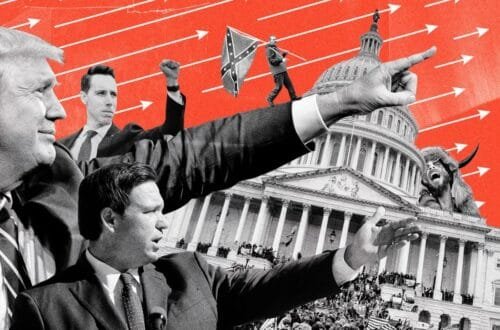Trump’s Approval Ratings: A Comedic Case Study by Fox News

The Unlikely Poll: Trump vs. Trump
Recent polling data from Fox News has brought to light intriguing insights into the approval ratings of former President Donald Trump during his second term, marking a notable divergence from his initial tenure. This analysis highlights that at the 100-day mark of his second term, Trump’s approval ratings are the lowest recorded when compared both to his first term and to those of his predecessors. Such findings prompt a deeper examination of the factors contributing to this phenomenon and its broader implications.
The significance of this Fox News poll cannot be overstated. It encapsulates not only the sentiment of the American populace regarding Trump’s current political standing but also juxtaposes the challenging political climate he faces. The assessment reveals that the only president to receive a lower approval rating than Trump during his first term is, perhaps humorously, Trump himself in his second term. This irony serves as a compelling narrative, illustrating the complexities of public opinion.
Moreover, the ironic nature of Trump’s positioning in this poll underscores the often fluctuating and unpredictable nature of approval ratings in American politics. As voters reflect on their experiences, it becomes evident that even figures previously associated with high favorability can encounter significant dips, particularly when expectations are not met. Observing this poll not only offers humor but also necessitates reflection on the influence of political context on public sentiment.
The Comedy of Errors: How Fox News Delivered the News
On an otherwise regular evening broadcast, Fox News unveiled a poll that sent shockwaves through its viewer base, revealing a notable decline in Trump’s approval ratings. The moment encapsulated a blend of disbelief and humor that could only be likened to a comedic sketch. As the host introduced the segment, the tone oscillated between incredulity and forced levity, emphasizing the absurdity of the situation where a singular individual, the president, displayed the lowest approval ratings against himself.
The initial announcement of the poll results was met with a palpable tension in the studio. The host, seemingly caught between professional decorum and the ridiculous nature of the news, delivered the facts in a manner that could best be described as both earnest and farcical. This juxtaposition was not lost on the audience, as laughter broke out from both the viewers at home and the studio audience alike. The absurdity reached its peak when the graphics illustrating Trump’s dismal approval ratings flashed onscreen, accentuating just how stark the numbers were. This was not just a political report; it morphed into an unintended comedy of errors, showcasing the transient nature of public opinion.
It became apparent that while Fox News intended to present serious journalistic findings, the presentation inadvertently transformed into a theatrical display. The anchoring team, along with their puzzled expressions and forced humor, created an atmosphere that was undeniably comedic. This incident sheds light on the challenges faced by Trump’s approval ratings and the often unpredictable nature of reporting in modern media. As such, the entire broadcast served as a reminder of the complex interplay between politics and satire, leaving the audience to reflect on both the numbers and the hilarity of the delivery itself.
Public Reaction: Laughter or Disbelief?
The release of Trump’s approval ratings by Fox News has generated a spectrum of reactions, primarily on social media platforms. Many users expressed disbelief at the reported numbers, finding them inconsistent with their own perception of the former president’s impact on the nation. This disconnect has led to a wave of humorous responses, where memes and satirical commentary began dominating feeds. Various social media influencers took it upon themselves to create content that highlights the absurdity of the approval ratings, implying a significant divide between established media narratives and grassroots sentiments.
Memes depicting Trump in exaggerated and comedic scenarios based on the poll results quickly gained traction, with users using humor as a coping mechanism to process their disbelief. With phrases like “Well, if you believe this, I have a bridge to sell you,” circulating widely, it is evident that many audiences found the news more laughable than commendable. This trend reflects broader skepticism about the reliability of polls, particularly those concerning polarizing figures like Trump, who have had a tumultuous political journey.
There are also indications of genuine admiration among certain segments of Trump’s support base, who interpret the approval ratings as a reaffirmation of his influence even amidst controversies. These viewers tend to share the results with a sense of pride, framing them as validation of Trump’s policies and approach to governance. This divergent sentiment displays a complex, layered reaction where portions of the audience oscillate between humor, disbelief, and admiration, depending on their political alignment and personal experiences.
Analysing the myriad reactions provides insight into the dynamics of public opinion surrounding Trump’s presidency. The mixture of laughter and serious concern highlights the contentious nature of political discourse in contemporary America, where approval ratings serve not just as numbers but as a catalyst for deeper reflection on the state of democracy and civic engagement.
The Bottom Line: What This Means for Trump’s Legacy
Analyzing the implications of Trump’s shrinking approval ratings highlights significant considerations for his legacy and public perception. The polling results showcased by Fox News reveal a concerning pattern that suggests extensive polarization among the electorate. As his approval ratings dip, Trump’s image as a divisive figure takes precedence, overshadowing any attempts at portraying his presidency in a positive light. This emerging narrative poses questions about how history might interpret his time in office, especially when juxtaposed with the frequent media reports calling him the ‘president with the lowest approval ratings.’
Public perception is crucial in defining a political legacy, and Trump’s ratings certainly play a pivotal role. As these numbers become further entrenched in political commentary, they may influence not just individual opinions but also the overall landscape of future elections. Voters who once supported Trump may reevaluate their choices in light of new information, reflecting on his policies and their implications. The power of such statistics cannot be understated as they serve as a barometer for the electorate’s sentiment, shaping the discourse leading up to critical election cycles.
Moreover, the comedic portrayals stemming from these approval ratings serve to humanize Trump in unique ways, making the conversation around him both approachable and critical. Humor may become a mechanism through which the public embroils itself in serious discussions about his tenure, suggesting that his legacy might oscillate between being viewed as the ‘worst president ever’ and simply as a political figure who experienced unprecedented levels of criticism. The duality of these narratives could complicate future assessments of his impact, illustrating the complexity of political legacies forged in times of great strife and division.




